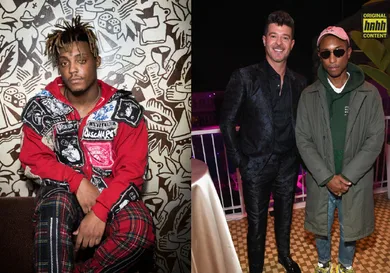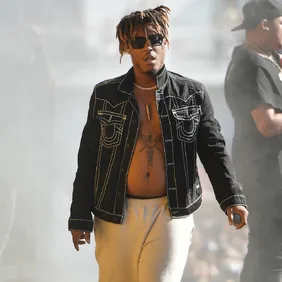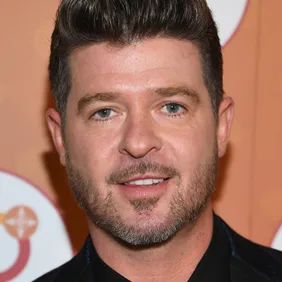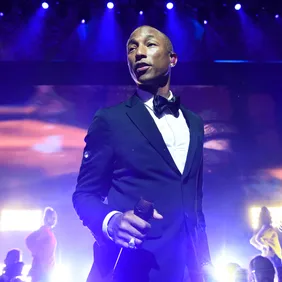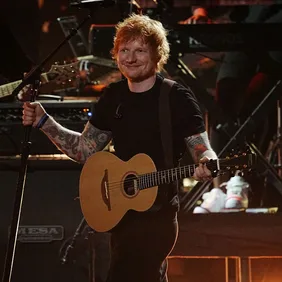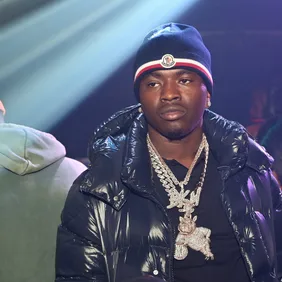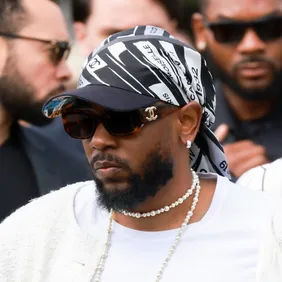Cases of copyright infringement in the music industry are far from new. As these cases are reviewed by juries and judges who are not music scholars themselves, the already-blurred lined between paying homage and theft has become more about any given perception of the line, as opposed to the actuality of it. You can’t technically copyright a style, a flow, or a vibe, but some copyright cases have attempted to state otherwise. When Pharrell and Robin Thicke were famously sued by Marvin Gaye’s estate for the alleged similarities between “Blurred Lines” and Gaye’s “Got To Give It Up,” many scholars believed that the jury based their decision off of the song's feeling the same rather than them technically being the same. Pharrell and Robin Thicke were ordered to pay millions, but aside from the whopping sum of money, the “Blurred Lines” case left a bad taste on the music industry.
“It’s bad for music, because we’ve had an understanding of what a song is and now based on that one case, now there’s a question of what a song is,” Rick Rubin said to Pharrell about the case. “It leaves us as music makers in a really uncomfortable place making things because now we don’t know what we can do.”
Robin Thicke, Pharrell and T.I. perform at Pre-Grammys Gal, 2014 - Larry Busacca/Getty Images
In the midst of confusion, there’s been an increase in the number of copyright cases over the past few years. Since the “Blurred Lines” case seemed to inaccurately lean on style and feeling, artists and songwriters around the world got trigger happy, and now we’re seeing these types of cases on a more frequent basis. A few months back, Lizzo was hit with plagiarism allegations for the opening line of her hit single “Truth Hurts.” Around the same time it was announced that Juice WRLD was being sued by Yellowcard— despite his unfortunate death— for allegedly copying melodic elements in “Holly Wood Died” on his single “Lucid Dreams.”
Copyright claims are often refuted, but with the increased amount of cases and more so the logic behind them, it's clear that things are getting out of hand. We talked to some experts to trace back where exactly things went wrong and where the line should be drawn.
Tal Dickstein is a partner at Loeb & Loeb law firm who’s spent over a decade successfully representing music publishers, artists like Migos, record labels, and songwriters in cases of copyright infringement.
Jeff Peretz is a musicologist and co-director of musicianship & performance at the Clive Davis Institute of Recorded Music at New York University, who’s also spent over a decade as a primary expert reviewer in copyright cases.
With their knowledge, here’s everything you need to know about copyright infringement in music.
How Do Copyright Cases Come About?
Copyright cases arise when an artist or team hears a song that they feel contains stolen elements from something they’ve already created. That artist or team would then go on to file a complaint, but typically, both parties would try to settle the issue at hand before they step foot in a courtroom. Pharrell and Robin Thicke took this approach, but it’s not always guaranteed to work, and it can even backfire.
“What was used in the “Blurred Lines” case, is that Pharrell and Robin Thicke preemptively asked the judge to declare that there was no copyright infringement before the Gaye estate had the chance to bring the lawsuit. And that kind of bold, almost arrogant move was what then convinced the Gaye estate to go ahead with the lawsuit,” Peretz says.
When copyright cases arise, there are a few technical points that are often relied on to prove their case. “The line in reality is the melody chosen, the rhythm of the melody chosen, how it relates to the chord progression that's there, and the lyrics. Those are ownable elements in music,” Peretz said.
Now, since the “Blurred Lines” case, claims of copyright infringement are increasingly backed by those things you cannot technically copyright.
“You can't copyright a style, you can't copyright a vibe, you can't copyright a rhythm, you can't copyright a beat, you can't copyright a chord progression... So these things are reused and reshaped all of the time,” Peretz said. “And that’s exactly how Pharrell and Robin Thicke got caught up when they attempted to make a song that made people feel the same as “Got To Give It Up”.”
How Much Use Is Necessary For Someone To Get Sued?
Lizzo’s summer was historically successful, and with that success people saw an opportunity. She’s currently facing plagiarism claims over the lyrics, “I just took a DNA test, turns out I’m 100 percent that bitch,” in “Truth Hurts”. Although she took the phrase from a viral tweet, she’s being sued by songwriting brothers Justin — who’s also penned songs for Charlie XCX — and Jeremiah Raisen, who claim that a variation of that phrase first appeared in a demo they co-wrote called “Healthy” back in April of 2017. After much uproar, Lizzo took to Twitter and Instagram to address the situation, explaining that she was inspired to use that short phrase from a meme. And while she didn’t know it originated from a tweet, she would give credit to the person it came from and not the brothers. Despite the phrase being such a short collection of words, does it matter how much of something is used?
Lizzo performs at Jingle Ball 2019 - Kevin Winter/Getty Images
"Not necessarily, not written into the law," Peretz says. "If you sample something, there's an inherent issue with taking care of it. There's an inherent license. When you use somebody's sample, you have to get it cleared. You have to get their permission. It doesn't matter how much if it's noticeable."
When Mark Ronson and Bruno Mars were hit with a copyright infringement case over “Uptown Funk,” The GAP Band’s Robert Wilson sued them for the similarities in the chorus of “Uptown funk you up,” as compared to The GAP Band’s “Oops upside your head.” Even though it was for three notes, in a specific order — and thus not even a melody, which would need to contain seven notes — the GAP Band still went forward with pursuing a case.
What’s The Legal Process Like?
When artists find themselves dealing with a possible case of copyright infringement, they often try to settle before the case gets to trial. Artists often do this out of fear of bad press and being seen as a thief, Peretz tells us, even if the case brought against them isn't very strong; meaning, it might be centered around one of the non-"ownable" elements (rhythm, style, vibe).
If both sides can’t reach an agreement, there are some things that happen before court. After a complaint is formed, defendants can file a motion to dismiss "which is an attempt to get the case thrown out without going through factual discovery, which can be very expensive," says Dickstein. This motion to dismiss, then, would not contain any factual review like a comparison of sheet music. A motion dismiss may happen "where the creative expression that is allegedly being infringed is a short lyrical phrase, or a short musical sequence,” Dickstein said. "The defendants may argue the plaintiff doesn't have any protectable rights in that short phrase, whether lyrical or musical, and therefore, as a matter of law, it can't support a copyright infringement claim."
In an attempt to avoid the repercussions, the defendant can then suggest that the plaintiff doesn't have any proper protectable rights in that short phrase. This is how Migos recently won their copyright infringement case over the phrase “Walk it like I talk it,” represented by Dickstein and his team.
“Statute of limitations is another argument that can be raised on a motion to dismiss. There's a three year statute of limitations for copyright infringement claims. So, if there's no allegation that the copyrighted work has been streamed, performed, copied or otherwise exploited in the three years before the complaint was filed, you may have the motion to dismiss on statute of limitations grounds,” Dickstein explained.
If the motion to dismiss is denied, then the next step is the discovery stage where the opposing sides will go through formal interviews (known as depositions) and request documents and information that may support their claim or defenses.
“An artist or songwriter who is alleged to have infringed someone else's song may be deposed about when and how they created their song, and whether they ever had access to the plaintiff’s song. The copyright infringement plaintiff will typically also be deposed, and asked about how he or she created their song, about any interactions they may have had with the defendant, or whether the song was widely distributed in the market such that the defendant would have even had an opportunity to hear it and to copy it,” Dickstein explained.
Next, a defendant would be able to file something called a motion for summary judgement which states that through the process of discovery, no jury can decide the verdict. So the judge must decide without going to trial. Considering how most juries don’t contain expert musicologists, a judge-decided verdict may be the safer option for the plaintiff. But a motion for summary judgement only occurs under certain parameters.
“And that could be because the documents and information produced in discovery show that the plaintiff doesn't actually own the song, that the defendants never had access to the plaintiff’s song, or the evidence shows that there is no substantial similarity between the songs, which is usually based on expert reports by musicologists,” Dickstein added.
If the summary judgment is denied, the case would then go to trial where twelve members of the jury would review how the songs were created, what similarities they may have, and how much the defendant made from that song. The public jury would then decide a verdict and damages if the defendant is found liable, but that’s one of the biggest problems in copyright infringement cases. The possibility of a public jury as opposed to music experts can sway things by not understanding musical composition, or even being slighted in opinion based off of an artist’s popularity.
“This is the way in which the "Blurred Lines" case was debacled. Everybody loves Marvin Gaye and let's just say that certainly played into the jury's decision making process, as opposed to just the musical act of the situation,” Peretz said. “And they're not experts, and that's the issue.”
In a technical sense, the jury would have to review and compare the sheet music between the featured songs. In the case of Juice WRLD, who’s still being sued by Yellowcard for, the verdict should come down to composition.
“I have a feeling that what they're arguing is going to be based off of the chord progression, which is not copyrightable and I can debunk it right now,” Peretz said. ""Lucid Dreams" has many more syllables happening in it, so it's not going to look the same."
Image provided by Jeff Peretz
Though this may sound like an end all be all justification, juries and judges still get the facts wrong, as Peretz believes they did in the “Blurred Lines” case. “The sheet music is completely different, so how they were relying on the sheet music and still wound up convicting them is a mystery,” he said.
What’s The Financial Breakdown?
Copyright infringement cases often involve a lot of money. When news broke that Juice WRLD was being sued over “Lucid Dreams,” the inaccurate figure requested by Yellowcard was slotted at $15 million dollars. Yellowcard’s law firm, King & Fallow, refuted that number with a correction that the members of Yellowcard, “are simply seeking what the law allows, and what parties in their position have sought in similar cases, which at this point is not determined.” However, suggesting a high number of funds to compensate for damages is not uncommon. In most cases, people throw out a shockingly high number on purpose because in the American judicial system, anyone can sue for any amount. If that request will be fulfilled is an entirely different question, though.
In the wake of his passing, Yellowcard is still moving forward with their lawsuit against rapper Juice WRLD - Dia Dipasupil/Getty Images
“I don’t give much credence to news reports indicating that a famous artist or record label is being sued for tens of millions of dollars,” Dickstein said. Copyright infringement plaintiffs have to prove that their claim has merit, and the court will then have to decide what damages, if any, the plaintiff is entitled to recover.
“In the copyright infringement context, the two types of available damages are statutory damages and actual damages. Statutory damages are set by law at between $750 and $30,000 per infringed work. If the plaintiff proves that the defendant acted willfully, which means the defendant knew or recklessly disregarded the risk of infringement, the maximum statutory damages are increased to $150,000 per work,” Dickstein explained. “But when lawsuits target hit songs that presumably made more than $150,000, the plaintiff will typically seek actual damages, as opposed to statutory damages. That includes any money the plaintiff may have lost as a result of the infringement, and, more importantly, the profits that the defendants made on the song.”
Even before the verdict, copyright infringement cases are expensive to pursue. Plaintiffs can get a contingency lawyer who will work for free, or a reduced fee and take a third of the awarded judgement once the case is concluded. That is, of course, if the plaintiff wins, but dependent on how much investigation has to be done and the possible hiring of musicologists, cases can run up thousands.
“It's not uncommon for legal costs and expenses in copyright infringement to run in the six-digit range and sometimes even higher, depending on how far the case progresses,” Dickstein admitted.
To prevent an artist’s bank account from taking a hit, rappers, singers, and songwriters are now strategically attempting to cover their grounds beforehand.
“Think about the song "Panini" by Lil Nas X. That little melody comes from a Nirvana song (“In Bloom”), those three notes. They could've probably have gotten away with that, but they didn't even want to take a chance, so Kurt Cobain was a co-writer on the song before it was even released,” Peretz pointed out.
How Does Copyright Infringement Work When It Comes To Sampling?
Sampling is without a doubt a key component of hip-hop. Artists like Lil Wayne with his Dedication and No Ceilings series, and more recently Tory Lanez with Chixtape V, have gained insurmountable steam by ripping other people’s songs. Whether it's a beat, like Lil Wayne would typically do on those mixtapes, or key vocals from a song as Tory Lanez does on the Chixtape series, the lack of a proper license can cause things to get ugly regardless if the project is released for profit or for free.
“If an artist samples someone else’s recording, they would need to license the recording, which is usually owned by a record label, as well as the underlying musical composition, which is usually owned by a songwriter or a music publisher,” Dickstein explained.
Despite it being a repeatable strategy in rap history, sampling someone’s flow is something that cannot be copyrighted, no matter how hard they bite it.
“There was a bunch of hoopla about the Ariana Grande song “7 Rings” because she used a specific rapping rhythm, as if it belonged to one person prior to her. Rappers saying triplets over trap beats; that's just in style right now, no one owns that,” Peretz explained. “While you may have beef on a social level with someone biting someone else's flow, there's no copyright infringement that could happen because no one can own a group of three notes over two beats, which is what a triplet is.”
Sampling isn’t that simple though. It sounds easy enough; to just get everything cleared, but that takes time and money that artists and producers may not have, especially if they don’t have a sample clearance department-- an big asset of major record labels. According to Peretz, artists and producers often have to go back and re-record things because they weren’t able to get all of the samples cleared. Or else, they find themselves in a situation where the sample clearance department of a record label runs out of money and can’t get the rest cleared for an album.
One way to get around sampling is fair use, which in certain situations, allows for an artist to use another artist’s music in their created work.
“There’s a famous fair use case in the music context where 2 Live Crew made a parody version of Roy Obirson's song "Pretty Woman", where they used more edgy lyrics to poke fun at Orbison’s more wholesome song,”Dickstein recalled. “That case went all the way up to the Supreme Court, which ruled that parodies are protected fair use.”
Even when it comes to specific lyrics, fair use can be applied as long as the lyrics are used in a different context.
Drake's "Pound Cake" fell under "fair use" territory - John Phillips/Getty Images
“There was a similar case decided a couple years ago where Drake’s “Pound Cake” was found to be fair use when it copied a few words from a 1982 spoken word track. Drake changed the words “Jazz is the only real music that’s gonna last” to “Only real music is gonna last,” and used it in a different lyrical context,” Dickstein said.
What Effects Do Copyright Infringement Cases Have On The Music Industry?
The “Blurred Lines” case changed a lot within the music industry. As we explained earlier, no one can copyright a style, a rhythm, and most importantly a feeling. As Peretz compared the two songs between Pharrell and Robin Thicke, he noted that the jury based their decision off everything but the sheet music. The loss for Robin Thicke and Pharrell was disheartening, but that was far from the first time a copyright case shook up the music industry.
“George Harrison was famously sued in the 1970s for copying from the Chiffons’ hit song “He’s So Fine” when he wrote “My Sweet Lord”, and Michael Bolton was sued in the 1990s for infringing the Isley Brothers’ “Love is a Wonderful Thing” when he wrote his song of the same name. So artists, record labels, songwriters, and publishers have had to contend with copyright infringement claims for quite some time, though it’s probably true that there has been an uptick in recent years,” Dickstein said.
An uptick is accurate, even more so in the world of rap. Although the genre doesn’t typically matter, the “Blurred Lines” case verdict may be the reason why we're beginning to see even more artists in our world getting tried for copyright infringement.
“I think that it's a precedent setting, it definitely ramped up people when it comes to running to their lawyers,” Peretz admitted. “ I don't know if the "Blurred Lines" case changed the music industry, it just made people a little bit more trigger happy when it comes to claiming theft. The minute somebody claims "so and so" stole something from my song, everybody jumps all over it. It's like a fist fight in the school yard; everybody stands around in a circle to try and see what will happen,” he continued.
How Can Artists Protect Themselves?
There’s a serious difference between using a certain style and stealing someone else’s exact idea. But the results of some major cases have made it clear that the difference isn’t necessarily as obvious as it should be. Artists are getting hit with lawsuits left and right, which can be both frustrating and scary. It’s tricky territory to navigate, too, seeing how no artist can remove their musical influences. So what can artists do to protect themselves?
“You can ask a thousand artists, and they'll tell you that they want to be original. Good luck, because there's no such thing. But it's about how much distance you can get from your influences,” Peretz suggested.
Although the line is so unstable, artists can still do a couple of things to avoid being sued.
“First, they can buy insurance for copyright claims. That may not make sense for an up-and-coming artist who isn't making much money, but as you become more successful, it's definitely something that you want to consider,” Dickstein explained. “Another thing that artists can do to protect themselves is to try to document, as best they can, how they create their songs, so if they’re accused of sampling someone else’s song, they can show that they got the sounds from somewhere else.”
Any artist who doesn’t legally protect their work is susceptible to accusations of stealing. And even with that protection, going to trial doesn’t provide an end-all be-all conclusion, seeing how even with sheet music, juries might improperly review the information based on a lack of knowledge. Since the entire music industry essentially thrives on influence, on using and refining previous musical eras, it’s scary to think how rampant and foul cries of copyright infringement will affect an artist’s most important right; the ability to create. To end with one final quote from Peretz:
"These shitty little lawsuits are really talking about style without even knowing that's what they're talking about, is dangerous because that'll start to limit the ways in which creative people can be creative. And then limit the ways in which somebody who is just starting out can learn to grow and potentially contribute something really spectacular to the art form, which goes against these laws in the first place."
If you liked this, check out:
WTF Are “Album Equivalent Units?" Streaming Numbers Explained
How Leaked Music Has Evolved In The Streaming Age
The Singles Era Is Upon Us (And What It Means For Music Consumption)
Stream Trolling: The Problem With Excessively Long Tracklists
